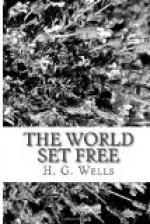It must be remembered that at this time men had still to spread into enormous areas of the land surface of the globe. There were vast mountain wildernesses, forest wildernesses, sandy deserts, and frozen lands. Men still clung closely to water and arable soil in temperate or sub-tropical climates, they lived abundantly only in river valleys, and all their great cities had grown upon large navigable rivers or close to ports upon the sea. Over great areas even of this suitable land flies and mosquitoes, armed with infection, had so far defeated human invasion, and under their protection the virgin forests remained untouched. Indeed, the whole world even in its most crowded districts was filthy with flies and swarming with needless insect life to an extent which is now almost incredible. A population map of the world in 1950 would have followed seashore and river course so closely in its darker shading as to give an impression that homo sapiens was an amphibious animal. His roads and railways lay also along the lower contours, only here and there to pierce some mountain barrier or reach some holiday resort did they clamber above 3000 feet. And across the ocean his traffic passed in definite lines; there were hundreds of thousands of square miles of ocean no ship ever traversed except by mischance.
Into the mysteries of the solid globe under his feet he had not yet pierced for five miles, and it was still not forty years since, with a tragic pertinacity, he had clambered to the poles of the earth. The limitless mineral wealth of the Arctic and Antarctic circles was still buried beneath vast accumulations of immemorial ice, and the secret riches of the inner zones of the crust were untapped and indeed unsuspected. The higher mountain regions were known only to a sprinkling of guide-led climbers and the frequenters of a few gaunt hotels, and the vast rainless belts of land that lay across the continental masses, from Gobi to Sahara and along the backbone of America, with their perfect air, their daily baths of blazing sunshine, their nights of cool serenity and glowing stars, and their reservoirs of deep-lying water, were as yet only desolations of fear and death to the common imagination.
And now under the shock of the atomic bombs, the great masses of population which had gathered into the enormous dingy town centres of that period were dispossessed and scattered disastrously over the surrounding rural areas. It was as if some brutal force, grown impatient at last at man’s blindness, had with the deliberate intention of a rearrangement of population upon more wholesome lines, shaken the world. The great industrial regions and the large cities that had escaped the bombs were, because of their complete economic collapse, in almost as tragic plight as those that blazed, and the country-side was disordered by a multitude of wandering and lawless strangers. In some parts of the world famine raged, and in many regions there




